EPA Publishes First RRP Enforcement of Lead Safe Work Practices
Today the EPA announced it's first enforcement actions against a renovator for violations of the lead-safe work practices required under the RRP Rule.
 The press release below explains how the violator was investigated after a YouTube video of the the renovator's workers in action was posted showing the total lack of lead-safe work practices in place as the workers used power equipment to remove paint on a rental property on Rockland ME.
The press release below explains how the violator was investigated after a YouTube video of the the renovator's workers in action was posted showing the total lack of lead-safe work practices in place as the workers used power equipment to remove paint on a rental property on Rockland ME.
EPA’s investigation found that Mr. Wentworth failed to: obtain required certification as a renovation firm from EPA; post warning signs in the work area; cover the ground in the work area with plastic sheeting to collect falling lead paint debris; contain waste from the renovation activities to prevent releases of dust and debris before the waste is removed from the work area for storage or disposal; prohibit use of machines that remove lead-based paint through high speed operation without HEPA exhaust controls; and establish and maintain records necessary to demonstrate compliance with the Renovation Rule.
Click here to watch the video which provided all the evidence the EPA needed.
 Will this be the first of many press releases by EPA regarding enforcement? Many contractors who have complied with the RRP rule hope so. According to Curt Spalding, regional administrator of EPA’s New England office: "Enforcement of these rules is important to protecting children and the business interests of those contractors who are following the rules.”
Will this be the first of many press releases by EPA regarding enforcement? Many contractors who have complied with the RRP rule hope so. According to Curt Spalding, regional administrator of EPA’s New England office: "Enforcement of these rules is important to protecting children and the business interests of those contractors who are following the rules.”
Time will tell if anyone else at EPA other Curt Spalding recognizes the importance of enforcement.
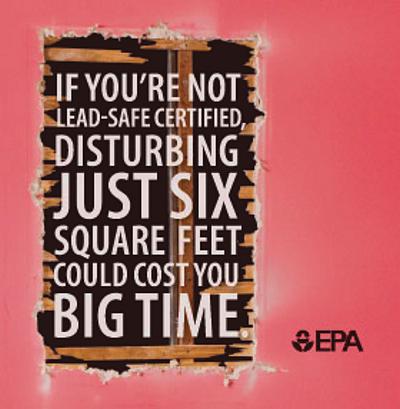
News Release
U.S. Environmental Protection Agency
New England Regional Office
May 16, 2011
Contact: David Deegan, (617) 918-1017
Maine Renovator Faces Penalty for Violations of Lead Renovation Rule
(Boston, Mass. – May 16, 2011) – A Rockland, Maine renovator is facing penalties for allegedly violating requirements designed to protect children from exposure to lead-based paint during painting and other renovation activities.
According to information gathered by inspectors from the Maine Department of Environmental Protection, the U.S. Department of Labor’s Occupational Safety and Health Administration and EPA, two workers employed by Colin Wentworth of Rockland failed to contain dust and debris generated by lead paint removal activities during a repainting project in October 2010. Although Mr. Wentworth had completed the eight-hour course required by the Lead Renovation, Repair and Painting (RRP) Rule, he did not provide the required training or supervision to his employees to ensure that they followed the required work practices prior to their use of high-speed dust-generating power tools to remove lead paint from the building. Mr. Wentworth also failed to take steps to obtain the mandatory lead-safe certification for his firm.
The violations were brought to EPA’s attention via an anonymous tip linking to a video of the violations, posted on YouTube and taken in October 2010. The video documented workers using power equipment to remove lead paint from an exterior wall of a residential building without using any containment for lead-containing dust and debris.
At least six children, one of whom was under six years old, lived in the four-unit building at the time of the project. Infants and young children are especially vulnerable to lead paint exposure, which can cause developmental impairment, reading and learning disabilities, impaired hearing, reduced attention span, hyperactivity and behavioral problems. Adults with high lead levels can suffer difficulties during pregnancy, high blood pressure, nerve disorders, memory problems and muscle and joint pain.
EPA’s investigation found that Mr. Wentworth failed to: obtain required certification as a renovation firm from EPA; post warning signs in the work area; cover the ground in the work area with plastic sheeting to collect falling lead paint debris; contain waste from the renovation activities to prevent releases of dust and debris before the waste is removed from the work area for storage or disposal; prohibit use of machines that remove lead-based paint through high speed operation without HEPA exhaust controls; and establish and maintain records necessary to demonstrate compliance with the Renovation Rule.
“In New England we have a high proportion of older houses where lead paint can still be present. It is critically important that all tradespeople understand and follow the RRP requirements so that during renovations, children are not exposed to lead and face serious, life-long health consequences,” said Curt Spalding, regional administrator of EPA’s New England office. “Many renovation firms have done the right thing by becoming certified, sending their employees to training and following the appropriate, health-protective work practices. Enforcement of these rules is important to protecting children and the business interests of those contractors who are following the rules.”
EPA’s Renovation, Repair and Painting Rule is designed to prevent exposure to lead-based paint and/or lead-based paint hazards. The rule requires individuals performing renovations for compensation at most pre-1978 housing to be properly trained. There are certification and training requirements for individual renovators and firms performing renovations to ensure that safe work practices are followed during renovations.
This is the first action EPA has brought against a company or individual for lead safe work-practice violations, under the Renovation, Repair and Painting Rule which became effective on April 22, 2010. The maximum penalty for the alleged violations is $37,500 per violation per day.
This case highlights the importance of high-quality tips that include the name, address, and phone number of the person who allegedly violated the rule, and contain details about the violations observed. While every such tip doesn’t always result in a formal enforcement action, EPA follows through on tips to identify if violations have occurred and if public or environmental health has been jeopardized.
- Report environmental violation tips anywhere in the USA (http://www.epa.gov/compliance/complaints/index.html)
- Report lead hazard tips in New England: (http://www.epa.gov/region1/enforcement/leadpaint/RenovationRepairPaintComplaintForm.html)
More information:
- Lead paint RRP rule (http://epa.gov/lead/pubs/renovation.htm)
- Why lead is a health hazard (http://epa.gov/lead/pubs/leadinfo.htm#health)
# # #
If you are looking for forms and signage to help you with comply with the EPA RRP rule, I recommend you check out what The Lead Paint Forms Store has to offer. They offer a complete assortment of multi-part carbon forms, signage and checklists to assist you and your employees with RRP compliance
 At a RRP workshop I attended last week, sponsored by the Lead and Environmental Hazards Association (LEHA), several renovators complained to Mike Wilson of EPA about EPA’s handling so far of the RRP rule. One after the other renovators cited examples of projects they had lost to other businesses that are ignoring the rule. Several even reported home owners had laughed at them when they tried discussing the rule and its requirements. One attendee reported that a homeowner actually told him that he would find another contractor who would ignore the rule as a way of saving money. It all seemed to be new news to Mike Wilson who told us he oversees RRP Policy, so could not comment specifically about enforcement. When asked what message he would bring back to the EPA in Washington after the meeting, Mike said he would let them know that regulated contractors wanted a level playing field. Attendees let Mike know that they have been already giving that same message to EPA, perhaps if Mike delivers the message the leadership at EPA will listen and take action.
At a RRP workshop I attended last week, sponsored by the Lead and Environmental Hazards Association (LEHA), several renovators complained to Mike Wilson of EPA about EPA’s handling so far of the RRP rule. One after the other renovators cited examples of projects they had lost to other businesses that are ignoring the rule. Several even reported home owners had laughed at them when they tried discussing the rule and its requirements. One attendee reported that a homeowner actually told him that he would find another contractor who would ignore the rule as a way of saving money. It all seemed to be new news to Mike Wilson who told us he oversees RRP Policy, so could not comment specifically about enforcement. When asked what message he would bring back to the EPA in Washington after the meeting, Mike said he would let them know that regulated contractors wanted a level playing field. Attendees let Mike know that they have been already giving that same message to EPA, perhaps if Mike delivers the message the leadership at EPA will listen and take action.
 Looking for accurate information about the EPA RRP rule?
Looking for accurate information about the EPA RRP rule?  The press release below explains how the violator was investigated after a YouTube video of the the renovator's workers in action was posted showing the total lack of lead-safe work practices in place as the workers used power equipment to remove paint on a rental property on Rockland ME.
The press release below explains how the violator was investigated after a YouTube video of the the renovator's workers in action was posted showing the total lack of lead-safe work practices in place as the workers used power equipment to remove paint on a rental property on Rockland ME.  Will this be the first of many press releases by EPA regarding enforcement? Many contractors who have complied with the RRP rule hope so. According to Curt Spalding, regional administrator of EPA’s New England office: "Enforcement of these rules is important to protecting children and the business interests of those contractors who are following the rules.”
Will this be the first of many press releases by EPA regarding enforcement? Many contractors who have complied with the RRP rule hope so. According to Curt Spalding, regional administrator of EPA’s New England office: "Enforcement of these rules is important to protecting children and the business interests of those contractors who are following the rules.” 
 On the other hand, since taking over the RRP Rule in MA, working with MA state officials has been much more productive. The Massachusetts Department of Labor Standards (DLS), formally called the Massachusetts Division of Occupational Safety, under the leadership of the department's Director Heather Rowe, has been very receptive to meeting with concerned stakeholders, hearing and recognizing stakeholder's concerns, and working with stakeholders to address their concerns. Currently, in addition to working on amendments to the RRP regulations in MA to address concerns, the DLS is also finalizing their plans to step up enforcement and compliance actions this spring as the home improvement season begins. Is it happening as fast as we all might like, no. However, based on budget and resource realities, I think DLS is doing a good job listening and prioritizing their efforts.
On the other hand, since taking over the RRP Rule in MA, working with MA state officials has been much more productive. The Massachusetts Department of Labor Standards (DLS), formally called the Massachusetts Division of Occupational Safety, under the leadership of the department's Director Heather Rowe, has been very receptive to meeting with concerned stakeholders, hearing and recognizing stakeholder's concerns, and working with stakeholders to address their concerns. Currently, in addition to working on amendments to the RRP regulations in MA to address concerns, the DLS is also finalizing their plans to step up enforcement and compliance actions this spring as the home improvement season begins. Is it happening as fast as we all might like, no. However, based on budget and resource realities, I think DLS is doing a good job listening and prioritizing their efforts. As one way to continue their efforts and interact with stakeholders, the Massachusetts Department of Labor Standards is looking for additional input from contractors and lead industry practitioners in anticipation of making amendments to the MA RRP regulations. An official from this agency will be participating in a May 18 workshop on the RRP Rule being held in Marlborough, MA sponsored by the Lead and Environmental Hazards Association (LEHA) and will be discussing the Department’s plans for revising the RRP regulations as well as the Department's enforcement efforts.
As one way to continue their efforts and interact with stakeholders, the Massachusetts Department of Labor Standards is looking for additional input from contractors and lead industry practitioners in anticipation of making amendments to the MA RRP regulations. An official from this agency will be participating in a May 18 workshop on the RRP Rule being held in Marlborough, MA sponsored by the Lead and Environmental Hazards Association (LEHA) and will be discussing the Department’s plans for revising the RRP regulations as well as the Department's enforcement efforts. On a web site by the name of
On a web site by the name of  Like construction workers who are exposed to lead in the course of their work, Gardeners should also consider that their skin and their clothes may become contaminated. Always wash your hands immediately after gardening and definitely before eating, drinking or smoking to avoid ingesting lead dust. To reduce the risk of bringing lead contaminated soil into the home, rinse and launder gardening clothing promptly. Being educated about the dangers of lead and ways to protect yourself as well as your family can help make sure you’re not growing a lead problem in your garden.
Like construction workers who are exposed to lead in the course of their work, Gardeners should also consider that their skin and their clothes may become contaminated. Always wash your hands immediately after gardening and definitely before eating, drinking or smoking to avoid ingesting lead dust. To reduce the risk of bringing lead contaminated soil into the home, rinse and launder gardening clothing promptly. Being educated about the dangers of lead and ways to protect yourself as well as your family can help make sure you’re not growing a lead problem in your garden. 
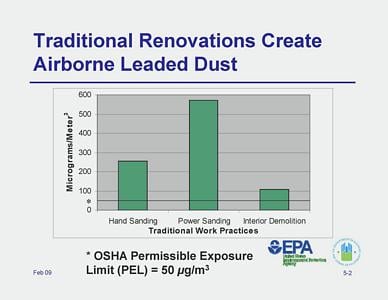
 Another key consideration in paint removal is the impact on wood, especially old, more valuable wood. Chemicals leach out natural resins and leave residue even after rinsing. High heat (1,100ºF) guns force paint pigment back into the wood and risk scorching and igniting wood. Sanding and shaving leave gouge and burn marks if not done skillfully. Pressure washing and new steam paint removal methods often leave irregular surface marks in the wood, drive moisture back into the wood, and create layers of “gray wood” which must be scraped away and or they will threaten the adherence of new paint. All of these methods can damage wood.
Another key consideration in paint removal is the impact on wood, especially old, more valuable wood. Chemicals leach out natural resins and leave residue even after rinsing. High heat (1,100ºF) guns force paint pigment back into the wood and risk scorching and igniting wood. Sanding and shaving leave gouge and burn marks if not done skillfully. Pressure washing and new steam paint removal methods often leave irregular surface marks in the wood, drive moisture back into the wood, and create layers of “gray wood” which must be scraped away and or they will threaten the adherence of new paint. All of these methods can damage wood. The time for the entire surface preparation process is reduced using the infrared heat method. Set up, operation, and cleanup are faster than with other methods. There is no extra time for rinsing, neutralization, drying, or sanding the wood; it is immediately ready for primer.
The time for the entire surface preparation process is reduced using the infrared heat method. Set up, operation, and cleanup are faster than with other methods. There is no extra time for rinsing, neutralization, drying, or sanding the wood; it is immediately ready for primer.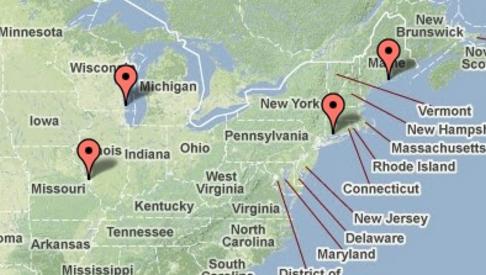
 In my opinion this tool will be helpful for those renovators following RRP requirements for a variety of reasons. For example, it will help level the playing field for legally operating businesses if the awareness of audits persuades illegal businesses to change their ways. Because the tool allows those reporting audits to include details about the audit, renovators will learn what to expect and how to better handle an audit if one happens to them. Also, for those who like to help their peers, being able to submit a report that is informative and shares constructive advice becomes a win-win for both the reporter and those who read the reports.
In my opinion this tool will be helpful for those renovators following RRP requirements for a variety of reasons. For example, it will help level the playing field for legally operating businesses if the awareness of audits persuades illegal businesses to change their ways. Because the tool allows those reporting audits to include details about the audit, renovators will learn what to expect and how to better handle an audit if one happens to them. Also, for those who like to help their peers, being able to submit a report that is informative and shares constructive advice becomes a win-win for both the reporter and those who read the reports. On the other hand, the tool will not likely be helpful to those who knowingly and willfully violate the rule. Knowing where EPA, OSHA and/or states agencies are doing inspections or audits won’t be much help in hiding from an inspector. As we have seen, job site inspections are not likely. Removing magnetic signs or parking their trucks out of view won’t protect violators from an audit. The required documentation gives the authorities the ability to retroactively inspect work practices as well as compliance with owner and occupant pre-notification requirements. Because the EPA rule dictates that all required documentation be kept for three years, one visit to a renovator’s office by EPA can uncover enough violations and justify enough fines to put an illegal business out of business. The Massachusetts requirement for storing documents is 10 years, giving illegal businesses in that state much more to be worried about.
On the other hand, the tool will not likely be helpful to those who knowingly and willfully violate the rule. Knowing where EPA, OSHA and/or states agencies are doing inspections or audits won’t be much help in hiding from an inspector. As we have seen, job site inspections are not likely. Removing magnetic signs or parking their trucks out of view won’t protect violators from an audit. The required documentation gives the authorities the ability to retroactively inspect work practices as well as compliance with owner and occupant pre-notification requirements. Because the EPA rule dictates that all required documentation be kept for three years, one visit to a renovator’s office by EPA can uncover enough violations and justify enough fines to put an illegal business out of business. The Massachusetts requirement for storing documents is 10 years, giving illegal businesses in that state much more to be worried about.


 The definition of ‘readily available’ varies widely. For example, OSHA allows up to 24 hours for businesses to produce some types of required records. When the EPA inspector walks in and asks for your RRP documents, you should be able to open a file drawer, pull out a box, or hand them a CD with all of your records within a 15 to 30 minute time frame. Otherwise, they pull out their ticket book and start writing violations.
The definition of ‘readily available’ varies widely. For example, OSHA allows up to 24 hours for businesses to produce some types of required records. When the EPA inspector walks in and asks for your RRP documents, you should be able to open a file drawer, pull out a box, or hand them a CD with all of your records within a 15 to 30 minute time frame. Otherwise, they pull out their ticket book and start writing violations. EPA does not allow hearsay compliance. If it isn’t written down, it didn’t happen. You can stand there and tell them that you used containment on every job. But, a picture of your jobsites with you pointing to the warning sign outside your containment demonstrates compliance beyond any doubt. Pictures are worth a thousand words…and don’t forget to set your date and time stamp on your photo.
EPA does not allow hearsay compliance. If it isn’t written down, it didn’t happen. You can stand there and tell them that you used containment on every job. But, a picture of your jobsites with you pointing to the warning sign outside your containment demonstrates compliance beyond any doubt. Pictures are worth a thousand words…and don’t forget to set your date and time stamp on your photo.

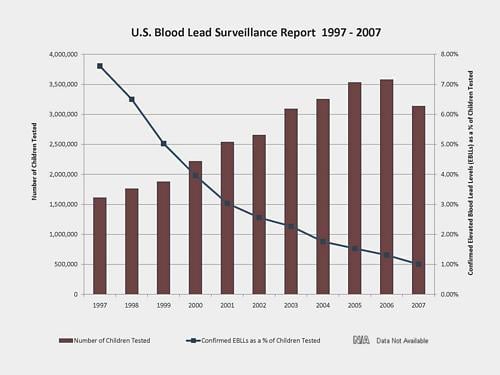

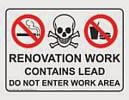 When you remove all the smoke and mirrors from this rule, the EPA can prove two thoughts; 1 Some remodeling activities create dust 2 Lead paint dust can create or raise EBLL’s Independent of each other those two statements can be proven, but the combination (which is a major foundational reason for RRP) is not so clear. Why?
When you remove all the smoke and mirrors from this rule, the EPA can prove two thoughts; 1 Some remodeling activities create dust 2 Lead paint dust can create or raise EBLL’s Independent of each other those two statements can be proven, but the combination (which is a major foundational reason for RRP) is not so clear. Why? Since I can’t explain to the customer the need for this rule, I encourage my customers and prospects to contact their state and federal representatives and ask them to provide facts and figures to explain the need for the RRP rule. To assist them with this, I supply them with a letter to send to their representatives along with a stamped and addressed envelope. I encourage all other contractors to consider doing the same.
Since I can’t explain to the customer the need for this rule, I encourage my customers and prospects to contact their state and federal representatives and ask them to provide facts and figures to explain the need for the RRP rule. To assist them with this, I supply them with a letter to send to their representatives along with a stamped and addressed envelope. I encourage all other contractors to consider doing the same.  ST. PAUL, Minn. – Feb. 17, 2011 – 3M announced today it has acquired Hybrivet Systems Inc., a leading provider of instant-read products to detect lead and other contaminants and toxins. Terms of the transaction were not disclosed.
ST. PAUL, Minn. – Feb. 17, 2011 – 3M announced today it has acquired Hybrivet Systems Inc., a leading provider of instant-read products to detect lead and other contaminants and toxins. Terms of the transaction were not disclosed. Hybrivet Systems Inc.’s flagship product is LeadCheck® Swabs, which is widely recognized as the fastest, easiest, most cost-effective lead detection product on the market. LeadCheck® has been at the forefront of lead detection and awareness since 1991.
Hybrivet Systems Inc.’s flagship product is LeadCheck® Swabs, which is widely recognized as the fastest, easiest, most cost-effective lead detection product on the market. LeadCheck® has been at the forefront of lead detection and awareness since 1991. Founded in 1987 by Marcia Stone, PhD, Hybrivet Systems Inc. is passionately dedicated to protecting the public from contaminants and toxins by offering a series of instant-read detection products. Recognized by the EPA, LeadCheck® Swabs are the most effective way for Certified Trainers and contractors to comply with the EPA Repair, Renovation and Painting (RRP) rule. Commercially available to all contractors, EPA trainers, and home owners, LeadCheck swabs help protect families, and especially children, against lead poisoning.
Founded in 1987 by Marcia Stone, PhD, Hybrivet Systems Inc. is passionately dedicated to protecting the public from contaminants and toxins by offering a series of instant-read detection products. Recognized by the EPA, LeadCheck® Swabs are the most effective way for Certified Trainers and contractors to comply with the EPA Repair, Renovation and Painting (RRP) rule. Commercially available to all contractors, EPA trainers, and home owners, LeadCheck swabs help protect families, and especially children, against lead poisoning.
 How we all choose to respond to the EPA’s oversight of the remodeling industry is a personal one. I will be the first to admit that initially I found it difficult to understand how invisible dust particles can cause serious health hazards. But with a little research, I got it. I suggest you can understand it too. Take my word for it, or look it up. I’m sure you will come to the same conclusion.
How we all choose to respond to the EPA’s oversight of the remodeling industry is a personal one. I will be the first to admit that initially I found it difficult to understand how invisible dust particles can cause serious health hazards. But with a little research, I got it. I suggest you can understand it too. Take my word for it, or look it up. I’m sure you will come to the same conclusion. The business part turns me on right now. However, I understand that there are those who prefer the hands on, the nail gun and the saw. I happen to prefer the keyboard and the pen. Having this new RRP rule is a huge challenge to incorporate into any business and I feel many of the same pressures you do. I believe following the rules and separating my business from others will take me to the next level of success. I also understand there are those who are seeing it from a totally different perspective.
The business part turns me on right now. However, I understand that there are those who prefer the hands on, the nail gun and the saw. I happen to prefer the keyboard and the pen. Having this new RRP rule is a huge challenge to incorporate into any business and I feel many of the same pressures you do. I believe following the rules and separating my business from others will take me to the next level of success. I also understand there are those who are seeing it from a totally different perspective. There is a sufficient body of scientific evidence that lead dust is created during renovation and while disturbing lead based painted surfaces. There is also a significant body of medical knowledge that lead is bad for people. I am educating my perspective clients as fast as I can. To the extent that they get it, and see a value in what I offer, I will be a clear choice for those who live in Pre 1978 homes.
There is a sufficient body of scientific evidence that lead dust is created during renovation and while disturbing lead based painted surfaces. There is also a significant body of medical knowledge that lead is bad for people. I am educating my perspective clients as fast as I can. To the extent that they get it, and see a value in what I offer, I will be a clear choice for those who live in Pre 1978 homes.


